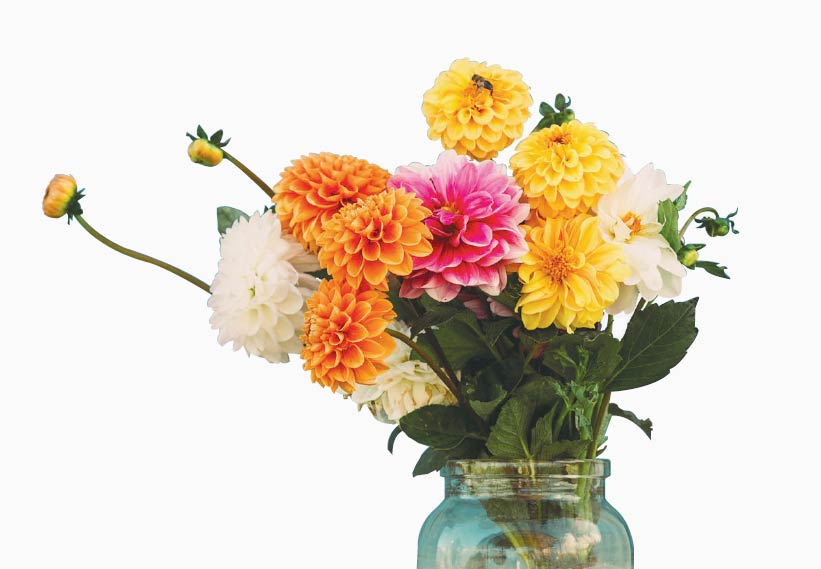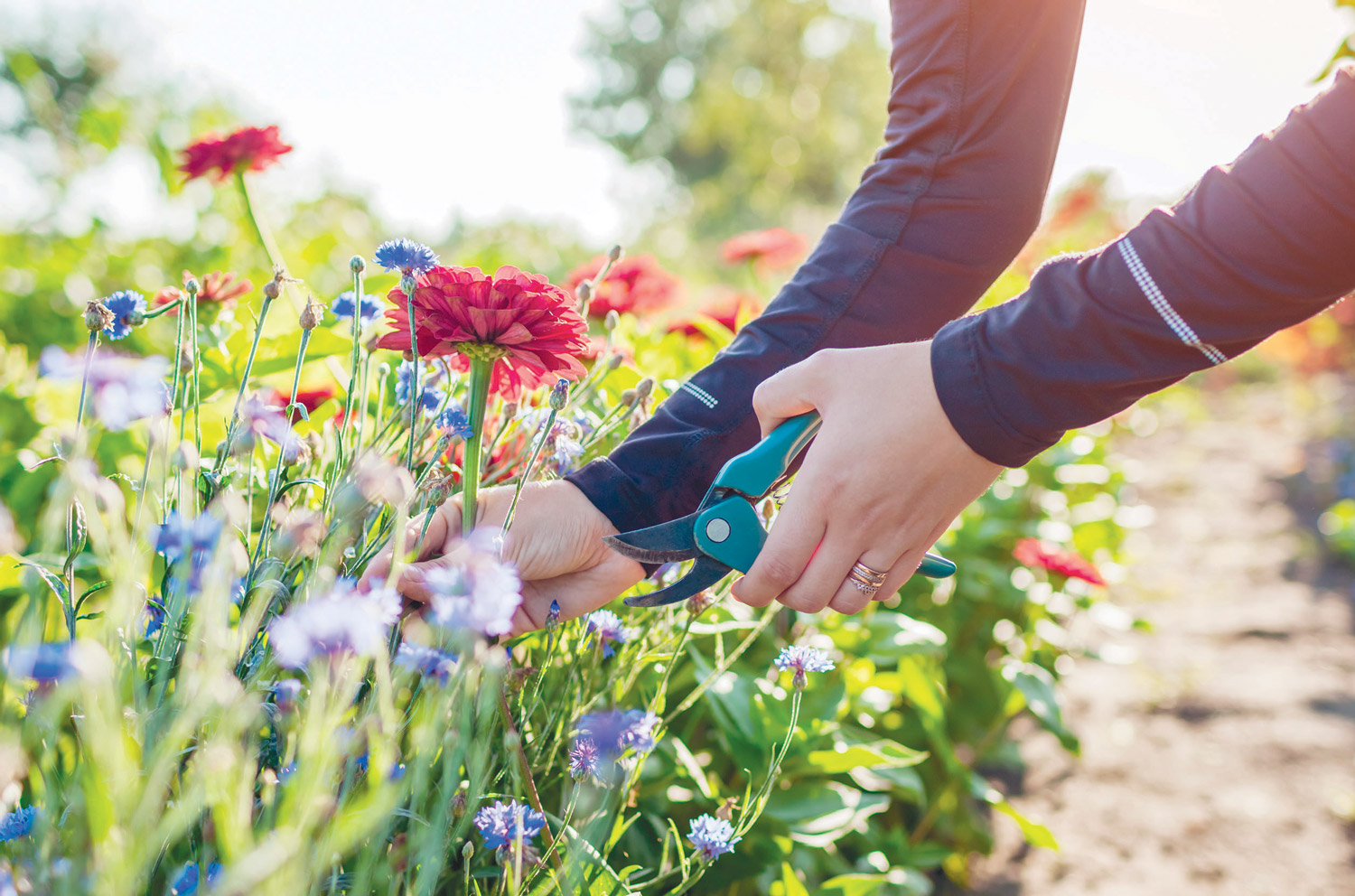Creating a Cutting Garden
A cutting garden allows you to share flowers all year long
One of the best parts of gardening is sharing my home-grown flowers with friends. When I get a dinner invite, I bring flowers from my garden whenever I can. Last November I brought dahlias to my family’s Thanksgiving, and this past February I brought a small vase with fragrant blooming witch hazel to a small dinner party. Even when nothing is blooming, I make beautiful arrangements with dried seed heads. The weather doesn’t always cooperate but if you plan it right, you can have something in a vase virtually year-round.
My cutting garden shares space with my vegetable patch, but really most of the things I pick are from the mixed borders around my property where I grow small trees, shrubs, perennials, and ornamental grasses in packed beds. When I want some flowers, I grab a vase (usually a recycled glass jar so I don’t have to ask for it back), fill it with water, and head out with my pruners.
In summer I start in my cutting garden for cosmos and zinnias, then tour my beds to see what else is blooming. If my jar isn’t full enough, I’ll add some ferns, rosemary, or colorful coral bell leaves to finish off. No, this is not your typical store-bought bouquet! It’s better. Less predictable. More unusual.
“One of the things that I love about flower farming is discovering how to utilize plants in floral design that are often overlooked,” agrees Samantha Rothman of Fairview Farm and Flowers, an organic flower farm in Morristown. “For instance, there are so many wonderful weeds like cress that add beautiful texture to arrangements. Or using grasses to give a design an airy element. Copper beech leaves and the catkins on birches are both wonderful. Even plants like raspberry, with their tiny green immature fruits, can make your floral designs look like a Dutch master’s painting. All it requires is to have new eyes when walking in nature: Look at the details of plants and you’re sure to find something interesting and worthy of highlighting in a vase!”
While not all of the flowers in your cutting garden will be native, they will still provide pollen and nectar. If you switch from pesticides and herbicides to using only organic fertilizers, and doing less tilling, you will still be part of the growing movement to garden responsibly.
ANNUALS
I put all my annual flowers in my vegetable garden because they require more care than the native flowers spread around my yard. More watering because they don’t have years to get their roots deep into the ground. More fertilizer because they have been bred to push flowers. And I add some liquid seaweed while they are flowering to help encourage more blooms. Liquid seaweed is a good organic fertilizer available at your favorite garden center, and is good for your veggies too.
My favorite annuals are cosmos, especially the orange ‘Sulphur’. Also zinnias, annual sunflowers, snapdragons, and marsh marigold. Since my gardens are mostly purples, blues, and pinks, I love the “hot” colors of annuals. They go well in my kitchen with my Fiestaware. Sometimes I start annuals from seeds, but many times I just purchase them at my local nursery. Last year I got a more unusual mix from my friends at Fairview Farm and Flowers. They offered a flat of mixed annuals for sale in the spring, so I got to try lisianthus, strawflowers, and amaranth.
BULBS AND TUBERS
Bulbs are important too. Just when we think we can’t stand another cold day, the daffodils pop up to remind us spring is coming! Daffodils can be had in colors from white to yellow to orange, from early bloomers to late. And deer don’t eat them. Spread them around wherever you will enjoy these spring harbingers the most, and don’t hesitate to snip them for inside.
The same with alliums: I probably have too many of these but I love them and they require no maintenance at all. They make me think of Dr. Seuss with their round cluster of tiny flowers. I have tons, from the late spring blooming 30-inchtall purple sensation to the tall but tiny flowered reddish drumstick blooming in late summer and everything in between. I save some of the faded seed heads to use in dried arrangements, and even spray paint them silver for the holidays.
Among my favorite bulb-like (actually tuber) flowers are dahlias—these are performers! Forget the dinner-plate-sized ones. The smaller dahlias are better in mixed vases. They come in every color, height, and size you can imagine. They are not cold-hardy in NJ, but with a little patience and TLC, you can dig up the tubers in the fall and save them to replant again next year.
PERENNIALS
My native perennials don’t need fertilizer or enriched soil so I scatter them all around my property along with small trees and shrubs. Of course, I don’t use insecticides, but I am OK with some insect damage. An eaten leaf means I am feeding beneficial bugs. (Learn more about the insects in your garden with the iNaturalist app.)
In these border beds I do less maintenance: less fall cleanup, less mulching, and no fertilizing at all. I leave the leaves so they will enrich the soil and provide overwintering habitat for insects, bees, and butterflies. I leave the stems so birds can have the seeds through the winter and so native bees can burrow into the stems and lay eggs in the spring. When spring comes, I cut back last year’s perennials, but leave about 15 inches of the stems standing, since the new plantings will soon cover up these great mini habitats.
My favorite native perennials for cutting, season by season, are:
—Spring: columbine, false indigo, and beardtongue;
—Summer: sunflowers (Helianthus and Heliopsis), black-eyed susans, bee balm, phlox, anise hyssop; and
—Fall: asters and New York ironweed. I round these off with some great native shrubs. The witch hazel I spoke of earlier, pussy willow, rhododendrons and azaleas, hydrangeas Annabelle and oakleaf and all their cultivars. If you clip a branch of witch hazel and bring it in, it will continue to open and fill your room with the most amazing fragrance, even in February and March!
The best nonnatives for cutting are peonies. Yes, they flop over in the rain, but cut them before the storm starts and enjoy them inside. Roses are great perennials for cutting, too, though I recently removed all mine. I don’t love them enough to give them all the real estate and care they need. But I do love lavender for its fragrant flowers and grey-green leaves stems as filler.
Summer is a great time to start a cutting garden, or add to your existing beds. You can keep your vases filled all season with a little bit of planning. Our local nurseries are full of great plants right now. Share your bounty.

PHOTO: ANNANAHABED / ADOBESTOCK
If you can’t have a cutting garden, there are several New Jersey flower farmers that can keep you in flowers.
NORTH:
Bloom & Bramble, Chester
localbloom.com
Fairview Farm and Flowers, Morristown
fairviewfarmandflowers.com
SpadaFlora Botanical Artistry/Free Range Flora, Asbury
facebook.com/spadaflora
CENTRAL:
Bees Berries and Blooms Farm, Annandale
facebook.com/Bees-Berries-and-Blooms-Farm-101984181397118
Bountiful Gardens, Ewing, Hillsborough, Lawrenceville
bountifulgardens.com
Farmer Meg’s, Hillsborough
megpaska.com
Flowers Bee Wild, Avon by the Sea
flowersbeewild.com
Flowers from the Farm, Farmingdale
flowersfromthefarmnj.com
Greenflash Farm, Princeton
greenflashfarm.com
Skinny Trees Farm, Hopewell
instagram.com/skinnytreesfarm
Plant Design Events, Wall Township
plantdesignevents.com
SOUTH:
Blushing Fields, Columbus
blushingfieldsflowerfarm.com
Garden in the Pines, Forked River
gardeninthepines.com
Petal & Pine Farm & Flower Co., Corbin City
petalandpinefarm.com
Summer’s Sunshine Flowers, Millville
instagram.com/summerssunshineflowers
Woodland Flower Farm, Cedarville
facebook.com/WoodlandFlowerFarm




